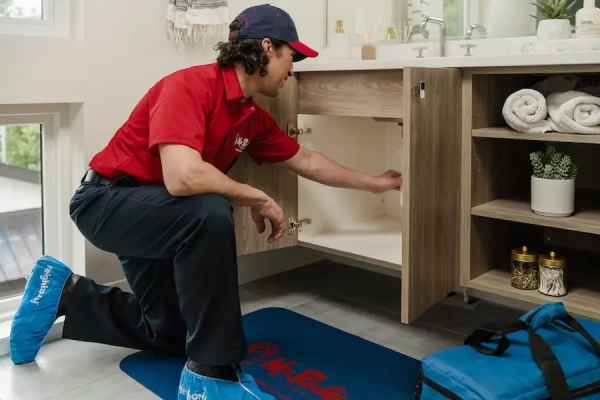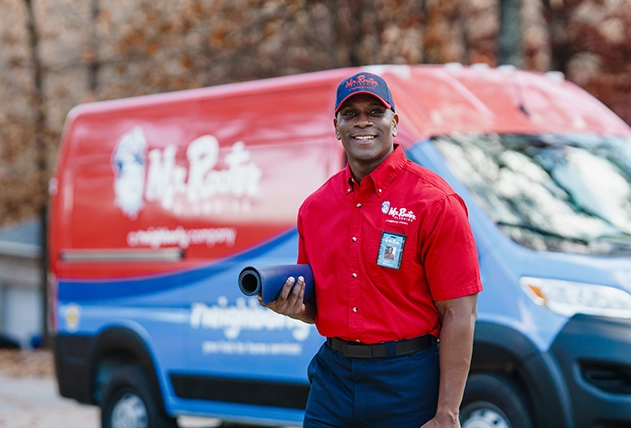
Summary:Mr. Rooter Plumbing® shares insight into what a water hammer is and how you can resolve it with a water hammer arrestor.
|
Have you ever noticed an awful banging or shuddering sound coming from your pipes? When not caused by high water pressure, loose valves, and worn pipes, this is called a water hammer. It often happens when water turns off quickly, typically at a washing machine, toilet, or dishwasher. However, it can also happen when you turn off a faucet very quickly!
The banging sound is caused by the shock of water stopping or changing direction in your pipes. A surge of pressure travels through the pipes as a shockwave, resulting in vibration and lots of noise! Unfortunately, water hammers don’t just result in noise; they can also cause pipe damage.
The good news is that most plumbing problems like this have a solution, and the solution for a water hammer is a water hammer arrestor. In this guide, you can learn what a water hammer arrestor is, how it works, why it matters, and how to install one yourself.
What Is a Water Hammer Arrestor?
A water hammer arrestor, also known as a plumbing shock arrestor, is a small plumbing component installed onto plumbing systems to absorb the shock of water coming to a sudden stop. Once a hammer arrestor is in place, you no longer have to hear all that clanging and banging when your dishwasher, washing machine, or similar, comes to a stop.
There are multiple types of water hammer arrestors available to achieve different goals:
- Piston-type: They have a sliding piston in a sealed air or gas chamber
- Diaphragm/bladder: They have a flexible membrane separating the air cushion from the water and are suitable for commercial and industrial plumbing systems
- Spring-type: They use an air chamber and a spring to absorb shock in high-pressure systems
- Simple air chambers: They have a capped vertical pipe to function as an air cushion
In homes, piston-type arrestors are the most common, which come in two convenient styles:
Inline Arrestors
Inline water hammer arrestors are installed directly into the water supply line and absorb the shock that a sudden valve closure can cause. They typically consist of copper, brass, and stainless-steel materials and have a piston chamber with a pre-charged air cushion.
They can have multiple connection types, like a push-fit, compression fitting, threaded, or soldered into copper pipe.
Mini End Stop Water Hammer Arrestor
If you need a water hammer arrestor for a washing machine, dishwasher, or another water-using appliance, ask your local plumber about installing a mini end stop water hammer arrestor.
Unlike inline arrestors, these models have a 90-degree fitting and a threaded end, designed to be attached to the hose of a dishwasher, washing machine, or similar. You also place them at the end of a pipe run, rather than in the middle like you would with an inline water hammer arrestor.
How to Install a Water Hammer Arrestor
If you’re ready to say goodbye to banging pipes, it’s time to install a hammer arrestor. Installation techniques can vary depending on the hammer arrestor you’ve purchased, where you’re installing it, and pipe type. We’ve included some general steps below, but you may also like to contact a trusted plumber for assistance.
What You’ll Need:
- A water hammer arrestor
- Wrench
- Bucket
- Towel
Tip: It’s a good idea to keep a tee fitting and a replacement supply line handy, just in case.
1. Turn Off the Water
Turn off the water supply valve and disconnect the supply hose to the water-using appliance or fixture. There will be water in the supply line, so have a bucket and towel ready to catch and absorb it. Ensure the area is dry before proceeding to step two.
2. Install the Water Hammer Arrestor
With the supply line disconnected, you can now attach the water hammer arrestor. Hand-screw it onto the water valve. You can install it in any position - vertical or horizontal.
Finally, hand-screw the water supply line onto the water hammer arrestor and appliance or fixture.
Secure the Hammer Arrestor
Use a wrench to tighten each end of the hammer arrestor and turn the water supply back on to check for leaks. Be sure not to overtighten it.
How to Know You Need a Water Hammer Arrestor
Even without being a plumber, property owners can determine the need for a water hammer arrestor by noticing a few obvious signs:
- Banging and thumping noises, such as when a washing machine starts or stops or a faucet is turned off abruptly.
- Your pipes are shaking or vibrating.
- Your water-using appliances have fast-closing valves.
- Your water pressure is above 60-80 PSI, which is when hammer problems are more common.
What Happens If I Don’t Install a Water Hammer Arrestor?
A hammer arrestor can be recommended to prevent plumbing system damage. Repeated hammering can result in frustrating and costly issues, including:
- Loose pipe joints
- Leaky faucet cartridges
- Premature appliance wear
Install a Water Hammer Arrestor with Help from Mr. Rooter Plumbing®
If you’re tired of clanging and banging pipes and worried about resultant plumbing damage, contact the licensed and insured plumbers at Mr. Rooter Plumbing® for water hammer arrestor installation.
Our experienced plumbers can install and replace water hammer arrestors for residential, commercial, and industrial plumbing systems. Book a service online or call us 24/7.

